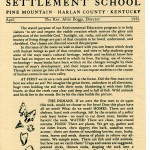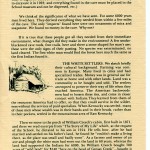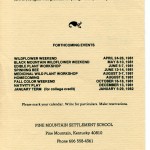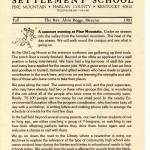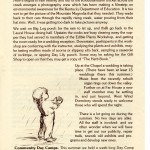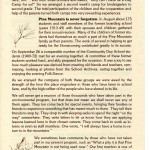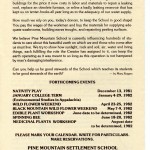Pine Mountain Settlement School
Series 17: PUBLICATIONS PMSS
NOTES 1981 April and Fall
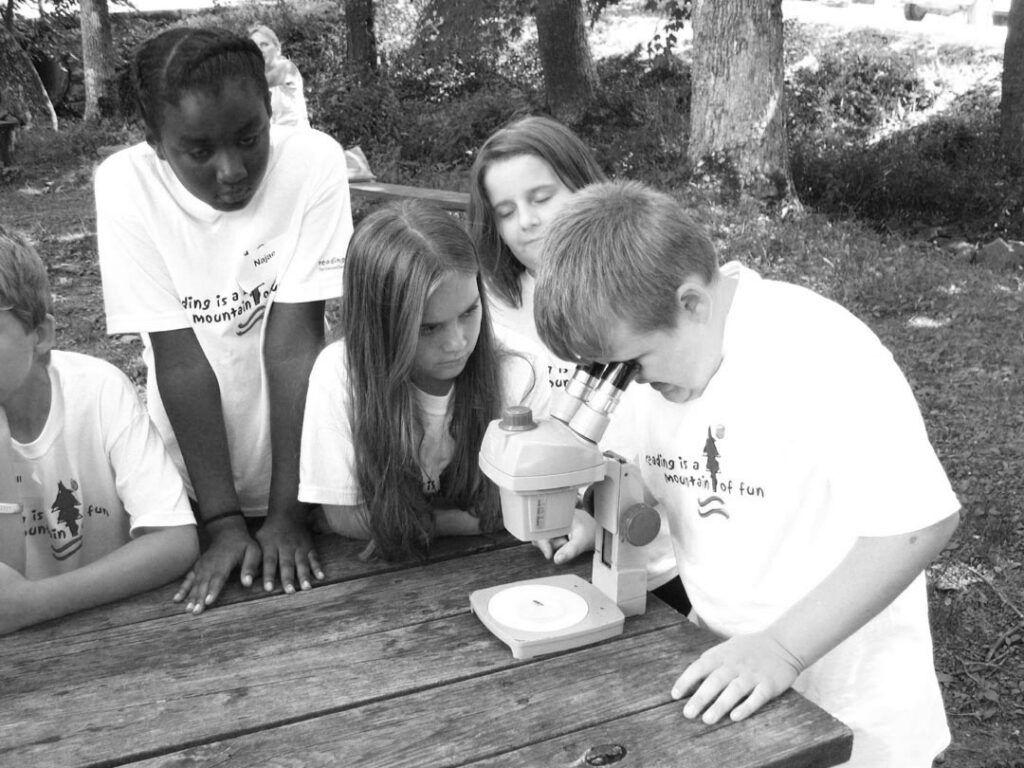
Environmental Education. Students try out a microscope. [IMG_0062-bw.jpg]
NOTES – 1981
“Notes from the Pine Mountain Settlement School”
April and Fall 1981
GALLERY: NOTES – 1981 April
We hope [Environmental Education] can serve to arouse thoughts about our individual responsibility for the world around us, and give some pointers for how we can face the future.
- NOTES – 1981 April, page 1. [PMSS_notes_1981_apr_001.jpg]
- NOTES – 1981 April, page 2. [PMSS_notes_1981_apr_002.jpg]
- NOTES – 1981 April, page 3. [PMSS_notes_1981_apr_003.jpg]
- NOTES – 1981 April, page 4. [PMSS_notes_1981_apr_004.jpg]
TAGS: Notes 1981 April, Environmental Education, Indian museum, Indian cave, settlers, Indians, Creech Cabin, William Creech, sheep, greenhouse, Mary Rockwell Hook, Boy’s Industrial Building, farm, carpenter bees, drawings, fundraising
TRANSCRIPTION: NOTES – 1981 April
P. 1
NOTES FROM THE
PINE MOUNTAIN
SETTLEMENT SCHOOL
PINE MOUNTAIN * HARLAN COUNTY * KENTUCKY
April The Rev. Alvin Boggs, Director 1981
The stated purpose of our Environmental Education program is to help visitors “to see and respect the visible creation which mirrors the glory and perfection of the invisible God.” Sunlight, air, rocks, soil and water, the community of living things are part of that creation to be loved, understood, and cherished. Our classes are directed toward this purpose.
In this issue of the notes we wish to share with you one lesson which deals with human beings as part of that creation, and tries to help students grasp some of the ways man’s cultural heritage, beliefs and technical know-how have had an impact on the world in which he lives. Farming, use of money, technology — many books have been written on the changes wrought by these factors of man’s development, and their impact on the world around us. Though we cannot go into all the theory, we can expose students to the course of human events in our own valley.
AT FIRST we sit on a rock and look at the forest. Did the first man to sit here see what we see? We imagine the great forest, unbroken in all directions, huge trees holding the soil with their roots, blanketing it with their fallen leaves, so that the creek runs clear and deep and is full of fish. Wild animals and birds live in the woods. Bit by bit the class builds the picture.
THE INDIANS. If we were the first men to sit upon this rock, would we choose to live here? Does this place have all we need? What do we need? HOMES. There are rock shelters, hard rock overhangs, left by the erosion of a softer rock layer below — no need to cut down trees; besides we haven’t the tools. WATER? There are clean, year-round streams. FOOD? There are plants. We get up, gather and eat violet leaves, chew [slippery] elm bark, sassafras roots, acorns — there are dozens of nourishing berries, nuts, barks, roots, leaves and seeds, dozens of plants to relieve our ailments. We sample some. There are fish and wild animals, but how can we catch them? Traps and snares are suggested, pointed sticks, thrown rocks, shaping the rock into a weapon. The limestone layer in Pine Mountain is rich in flint. CLOTHES? We could use animal skins, dress them with stone tools, sew with a bone needle and sinew thread. FUEL? Fallen tree boughs. We come to the conclusion that if the population were small, hunter/gatherers could live well in this environment.
[Image: Sketches of several arrowheads.]
P. 2
We then go to our Indian museum, built up by what children and others have dug up in the Indian cave. The flint, sandstone, and bone tools, the bones, the broken bits of pottery bear out our hypotheses of how the Indians lived. We then go to the cave from which most of these things were excavated, and dig. We bring to light bones and chips of flint, maybe pieces of pottery and ochre, and occasionally, a source of special excitement, a worked flint artifact. (We are always careful to impress on the children some rudimentary archaeological rules, such as: This cave has already been disturbed, so it is okay to dig in it. The School called in experts from the University of Kentucky to excavate it in 1923; and everything found in the cave must be placed in the School museum and not be dispersed, etc.)
We think of the significance of what we have seen. For some 6000 years men lived here. They derived everything they needed from within a few miles of the cave. The only “imports” found here were two ornaments of mica and soapstone. We found no money in the cave. Why not?
If it is true that these people got all they needed from their immediate environment, what changes did they make in the environment? A few smoke- blackened cave roofs, foot trails, here and there a stone shaped for man’s use; these were the only signs of their passing. No species was exterminated, no land cleared. The first white man would find the forest here much the same as the first Indian found it.
[Image: Small sketch of the Creech cabin.]
THE WHITE SETTLERS. We sketch briefly their cultural background. Farming was common in Europe. Many lived in cities and had specialized trades. Money was in general use for trade at home and with other lands. Land was a commodity to be bought and sold. The settlers attempted to preserve their way of life when they reached America. The American backwoodsmen had to loosen these ties, and come in closer contact with Indians. They learned from them of the resources America had to offer, so that they could survive in the wilderness without the services of paid specialists. When Kentucky was settled, many of these men whose wealth was in their hands and in their heads, rather than in their pockets, settled in the mountainous area of East Kentucky.
Then we move to the porch of William Creech’s cabin, first built in 1871, and there we read excerpts from “The Story of My Life” which, at the request of the School, he dictated to his son in 1914. He tells how, after he had married and settled on his father’s land, he found he “couldn’t make a living there, as the place was small and badly worn”. As a farmer and owner of an axe and plough the white man had worn out the land in 60 years, whereas the land had supported the Indians for 6000. So William Creech bought 700 acres of “wild land” for $140 “here on the head of Greasy Creek” – bought it because a farmer must own his land, unlike the Indian hunter/gatherer who believed “you can’t buy land; land belongs to us all”.
P. 3
We see William Creech cross the mountain to his acres of virgin forest, building a cabin, bringing in his family. Then he records his long battle with the trees “to clear enough for what we needed”. The great trees were felled and burned, and slowly the soil began to bleed into the creeks. Farmers in this area needed rifles to protect crops and stock from “varmints”. They exterminated many species, and decimated countless others. We go into the cabin and think of the family who lived there. How much they needed to know! How to build, farm, work in leather, blacksmithing, soap making, provide their own recreation, music, songs, dance — preserve their food. By their labor nearly all their needs were supplied from the immediate environment. Their only regular purchases were salt and gunpowder.
[Image: Small sketch of a sheep and a lamb.]
We try to imagine how it was when “an average family of say a round dozen could get by on $25 cash a year.” So we study how you would get a new garment. We visit the sheep. We pick, card, and spin wool. We look at dye processes. We hear how flax was grown and prepared to spin into linen thread. We take our spun yarn to a loom, and make cloth. We look at a linsey-woolsey dress. They understand that the only trade outlay for such a garment would be the cost of a needle.
Even in this simple life, what changes did the white settlers bring to the environment? How did the other changes come about? And why? (Different types of housing, roads, cars, power lines, phone lines, stores, logging camps, mining camps, deep mines, strip mines, etc.) Is the environment as a whole healthier for them?
We hope this lesson can serve to arouse thoughts about our individual responsibility for the world around us, and give some pointers for how we can face the future.
The above lessons do not demand extensive cash outlay. We are working with the Indian cave and the cabin which we have, though after over a century the cabin has needed a new roof, new porch, some new floor puncheons. These cost labor and money. But we are dreaming of a project that deals with the future as well as the preservation of the past. Many Pine Mountain students will remember the greenhouse Mrs. Mary Rockwell Hook incorporated in the second Boys’ Industrial Building, now our main classroom building. We are hoping to apply for a grant to restore it as a fully operative solar facility. It will help our farm department raise food for the groups that come here, serve as a demonstration and learning area for environmental classes, help with fuel bills of this large building, and be used as a pilot project for our neighbors and institutions throughout the mountain area.
However, over the years, carpenter bees and other insects have hollowed some of the main supporting timbers, causing cracks to appear in the stone work. The roof leaks. The whole building needs repainting. The fire marshall…
P. 4
…has demanded extensive alterations if we are to continue to use it for school classes. These repairs will be necessary whether we get the grant for the new project or not. If we do get it we will have to make some of these repairs before work can get under way. We have great faith in the value of the work, but we do have to have money to keep our buildings in repair. Can you help us? We continue to rely on our many friends to supply what is needed to keep our program operative and creative. You have never failed us in the past and we turn to you again with gratitude for past generosity and hope for the future.
**********
FORTHCOMING EVENTS
WILDFLOWER WEEKEND…………………………….APRIL 24-26, 1981
BLACK MOUNTAIN WILDFLOWER WEEKEND…..MAY 8-10, 1981
EDIBLE PLANT WORKSHOP……………………………..JUNE 5-7, 1981
SPINNING BEE…………………………………………….JUNE 12-14, 1981
MEDICINAL WILD PLANT WORKSHOP…………AUGUST 3-7, 1981
HOMECOMING……………………………………………..AUGUST 8, 1981
FALL COLOR WEEKEND…………………………OCTOBER 16-18, 1981
NATIVITY PLAY………………………………………..DECEMBER 13, 1981
JANUARY TERM (for college credit) …………JANUARY 5-29, 1982
Please mark your calendar. Write for particulars. Make reservations.
PINE MOUNTAIN SETTLEMENT SCHOOL
Pine Mountain, Kentucky 40810
Phone 606 558-4361
GALLERY: NOTES – 1981 Fall
We believe Pine Mountain School is currently influencing hundreds of students to care about this beautiful earth on which we and those who come after us must live.
- NOTES – 1981 Fall, page 1. [PMSS_notes_1981_fall_001.jpg]
- NOTES – 1981 Fall, page 2. [PMSS_notes_1981_fall_002.jpg]
- NOTES – 1981 Fall, page 3. [PMSS_notes_1981_fall_003.jpg]
- NOTES – 1981 Fall, page 4. [PMSS_notes_1981_fall_004.jpg]
TAGS: Notes 1981 Fall, A walk around campus, Old Log House, swimming pool, Environmental Education, ball field, Library, folk dancing, sheep, Kentucky Department of Education film crew, Laurel House events, Edible Plants Workshop, Chapel weddings, Community Day Camp activities, Homecoming for boarding school students, building maintenance, appeal for donations
TRANSCRIPTION: NOTES – 1981 April
P. 1
NOTES FROM THE
PINE MOUNTAIN
SETTLEMENT SCHOOL
PINE MOUNTAIN * HARLAN COUNTY * KENTUCKY 40810
TELEPHONE 606 / 558-4361
Fall The Rev. Alvin Boggs, Director 1981
A summer evening at Pine Mountain. Cooler air streams into the valley from the forested mountain. The heat of the day abates. We will walk round the campus and see what is going on.
At the Old Log House at the entrance workmen are gathering up their tools. The porch floor is nearly finished. Beyond at the office an applicant for a staff position is being interviewed. We have had a big turnover of staff this year and many have applied for the vacant jobs. With a great sense of loss we have said goodbye to trusted, trained and gifted workers who have made so great a contribution to the work here, and now we are learning the strengths and abilities of those who have come to take their places.
We pass along the road. The swimming pool is full, and the pool supervisor, who may have already had two or three other groups this day, is wondering if she can admit all of the people who have come to the community swim. Really, 75-100 people are too many for our small pool. In the nearby Environmental Education office the program coordinator, who has been busy all day with a workshop, is writing letters and making phone calls to arrange the schedule of events for the next few days.
In the ball field beyond several young parents, our own former students of not so long ago, are either coaching a group of T-leaguers, or watching to see how their offspring perform before they drive them home again and we welcome a chance to visit with them.
We go on down the road to the Library where a researcher is using our Archives to explore the relevance of the type of community high school education evolved here during the thirties and forties to educational needs in high schools today. We wonder how his work is affected by sounds from the black-top playground. Here over 100 teenagers are gathering for an evening folk dance after a hard day’s work. Each week for seven weeks this summer a fresh group of members of Methodist Church congregations from all over the United States camped in the Burkham schoolhouse and spent their days…
P. 2
…working on house repairs — new roofs, paint jobs, porch mending — in houses in the neighborhood where the occupant was unable to do the work himself. Once a week a similar group from Leslie County joined them here for a party. A little further up the road we find a band of casual visitors feeding the sheep, and a staff member seizing a few moments to work in his garden.
Now it begins to rain heavily and out of the Rhododendron thicket across the creek emerges a photography crew which has been making a filmstrip on environmental awareness for the Kentucky Department of Education. It is too wet to get the picture of the Mountain Magnolia that they needed. They wade back to their cars through the rapidly rising creek, water pouring from their hat rims. Well, it was getting too dark to take pictures anyway.
We wait on Big Log porch for the rain to let up, and then go back to the Laurel House dining hall. Upstairs the cooks are busy clearing away the supper they had served to members of the Edible Plants Workshop, and getting the room ready for a wedding reception. Downstairs, participants in the workshop are conferring with the instructor, studying the plants and exhibits, maybe tasting muffins made of acorns or slippery elm bark, sampling a casserole of rocktripe, or sipping Day Lily punch. Some may be asking for the Gift Shop to open so that they may get a copy of “The Herb Book.”
Up at the Chapel a wedding is taking place. (There have been at least 15 weddings there this summer.) Music from the recently rebuilt organ rings out down the valley. Further on at Far House a new staff member may be settling in, and just beyond, West Wind Dormitory stands ready to welcome those who will spend the night.
There is a lot going on during the summer. No two days are alike. All the staff is involved and we often wonder when we will have time to get out our publicity, repair trails, rework old exhibits and programs and develop new ones.
[Image: Sketch of a small child catching raindrops.]
Community Day Camps. This summer we held a week-long Day Camp for children of this community in grades 3-7. One mother, a teacher who had attended one of our college terms in January, volunteered to help teach. Other parents brought the children punctually every morning, collected them in the afternoon, and helped serve a splendid picnic on the last day. The children were enthusiastic, intelligent, cooperative.
P. 3
They climbed the mountain, went on discovery hikes, studied the habits of the animal of the day (worm, snake, turtle, etc.), learned about Indians and their own pioneer forebears, used the compass, did crafts, cooked applesauce, sprouted beans, collected wild salads, played games, and had swimming lessons. They seemed to relish everything. The only complaints were, “Can’t we have it for two weeks next year?”, “Couldn’t we spend the night here, too?”, and from small brothers and sisters, “Why can’t there be a Day Camp for us?” So we arranged a second week’s camp for kindergarten to second grade. The total participation of the children and the cooperation and help of the parents turned both camps into very rewarding experiences.
[Image: Small sketch of a leafless branch.]
Pine Mountain is never forgotten. In August about 175 students and staff members of the former boarding school (years 1913-49) with their spouses and children gathered for their annual reunion. Many of the children of former students feel themselves as much a part of the Pine Mountain family as their parents. The work of several in helping to get ready for the Homecoming contributed greatly to its success.
On September 26 a comparable number of the students (1949-72) met for an evening together. A committee of these former students worked hard, and ably prepared for the occasion. It was a joy to see how much pleasure was derived from meeting old friends and teachers, reminiscing, looking at photos from the School Archives, eating together and enjoying the evening Folk Dance.
As we enjoyed the company of both these groups we were awed by the strength of the love this place engenders in those who have been in school here, and by the high caliber of the people who have shared in its life.
We will never get a reunion of those thousands who have taken part in the environmental program, but that does not mean we shall never see any of them again. They too come back for special events, bringing their families or friends to experience something that has meant much to them. They tell their friends to stop by. They drop in with sleeping sacks to spend the night “on the way” somewhere. They write letters to let us know how they are applying lessons learned here in their chosen careers. They come back to work as interns or even as staff members. One wrote, “I will always have a home to return to in the mountains.”
[Image: Small sketch of a branch with leaves.]
We sometimes hear comments by those who have not taken part in our present program, such as “What a pity it is that Pine Mountain is not being used now.” Our first reaction is one of amazement until we realize the speaker either knows nothing about the present program, or that he sets so high a value on the experience he once enjoyed at Pine Mountain that he cannot bear to see any changes. On the other hand we also face criticism that “The place is suffering from over-use.” The facilities do suffer…
P. 4
…from much use and old age, though it is a continual source of satisfaction to us that so many can use our forest trails, our outdoor work areas and our buildings and make so little impact on them. But whether the cause is old age or overuse, constant outlays have to be made to keep the place habitable and in good shape. Old water mains rust, and refrigeration units wear out. Farm trucks suffer from hard work. Old trees fall, old boards rot, and wiring short circuits. In the early days of the School’s history donors gave whole new buildings for the price it now costs in labor and materials to repair a leaking roof, replace an obsolete furnace, or reline a badly leaking reservoir that has kept us on tenter-hooks all year long as to the adequacy of our water supply.
How much we rely on you, today’s donors, to keep the School in good shape! You pay the wages of the workmen and buy the materials for supplying adequate washrooms, building eaves troughs, and repainting peeling surfaces.
We believe Pine Mountain School is currently influencing hundreds of students to care about this beautiful earth on which we and those who come after us must live. We try to show how sunlight, rock and soil, air, water and living things, each fulfilling the role the Creator has assigned to it, can keep the earth operating as it was meant to so long as this operation is not hampered by man’s damaging interference.
Can you help us be good stewards of the School which teaches its students to be good stewards of the earth? — by Mary Rogers
FORTHCOMING EVENTS
NATIVITY PLAY December 13, 1981
JANUARY COLLEGE TERM January 4-29, 1982
(Environmental Studies in Appalachia)
WILD FLOWER WEEKEND April 23-25, 1982
BLACK MOUNTAIN WILD FLOWER WEEKEND May 7-9, 1982
EDIBLE PLANT WORKSHOP June date to be determined, 1982
SPINNING BEE June 18-20, 1982
MEDICINAL PLANTS WORKSHOP August date to be determined, 1982
PLEASE MARK YOUR CALENDAR. WRITE FOR PARTICULARS.
MAKE RESERVATIONS.
PINE MOUNTAIN SETTLEMENT SCHOOL
Pine Mountain, Kentucky 40810
Phone 606 / 558-4361
Previous:
NOTES – 1980
Next:
NOTES – 1982
See Also:
HISTORY PMSS Summary 1980-1981
HISTORY PMSS Summary 1981-1982
PMSS STUDENT LISTS Guide
PMSS Workers Guide 1913 to Present
Return To:
NOTES Index

